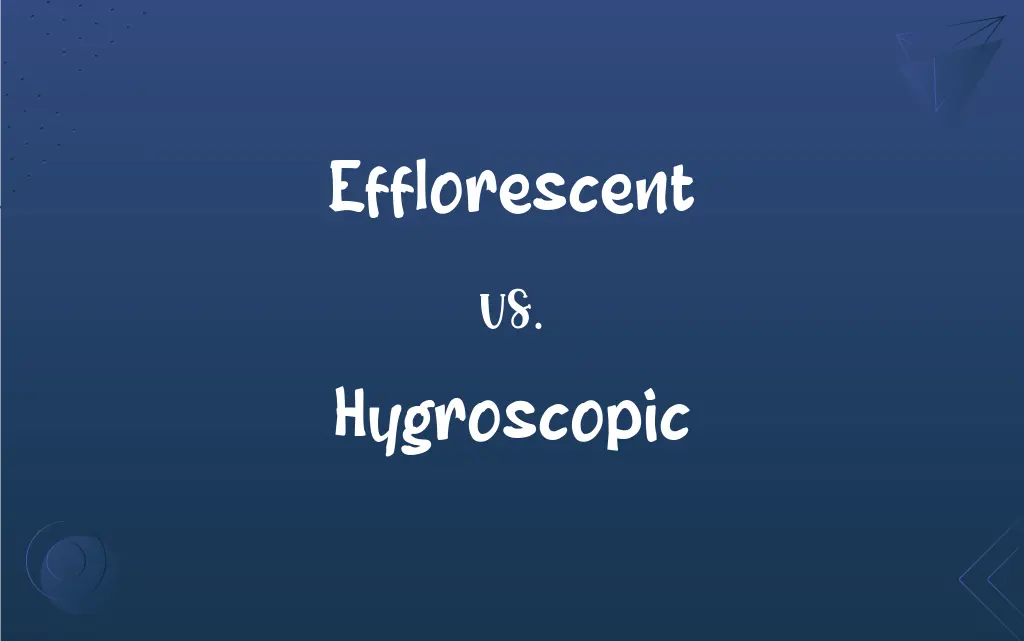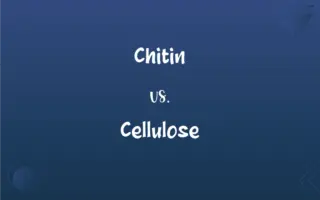Efflorescent vs. Hygroscopic: What's the Difference?
Edited by Aimie Carlson || By Harlon Moss || Updated on October 26, 2023
Efflorescent substances lose moisture to form a powdery surface, while hygroscopic substances absorb moisture from the air.

Key Differences
Efflorescent substances release water, leading to crystalline deposits. Hygroscopic substances attract and retain water molecules.
Efflorescent compounds often form a white, powdery residue. Hygroscopic materials can become damp or clumpy due to moisture absorption.
Efflorescent substances undergo a process called efflorescence. Hygroscopic materials exhibit hygroscopicity, absorbing water from their environment.
Efflorescent reactions are common in salts exposed to air. Hygroscopic reactions are observed in substances like silica gel, which absorb water.
Efflorescent materials can suffer from aesthetic degradation. Hygroscopic substances might change in weight and physical properties due to moisture.
ADVERTISEMENT
Comparison Chart
Moisture Interaction
Lose moisture, form powdery surface
Absorb moisture from the air
Common Reaction
Form crystalline deposits
Attract and retain water molecules
Typical Appearance
White, powdery residue
Can become damp or clumpy
Process
Efflorescence
Hygroscopicity
Material Changes
Aesthetic degradation
Change in weight and properties
ADVERTISEMENT
Efflorescent and Hygroscopic Definitions
Efflorescent
Tendency to form a powdery surface.
Efflorescent minerals often create a dusty appearance.
Hygroscopic
Capable of absorbing moisture.
The hygroscopic material kept the electronics dry.
Efflorescent
Prone to losing water to form crystals.
The efflorescent salt left a white residue on the container.
Hygroscopic
Often used as a desiccant.
Silica gel is a common hygroscopic substance.
Efflorescent
Causes aesthetic degradation.
The efflorescent effect on the brick wall was unappealing.
Hygroscopic
Can change physical properties due to moisture.
The hygroscopic powder became clumpy in humid conditions.
Efflorescent
Characteristic of certain hydrates.
Efflorescent substances like sodium sulfate are common in labs.
Hygroscopic
Attracts water molecules from its environment.
Hygroscopic compounds are essential in moisture control.
Efflorescent
Exhibits efflorescence upon exposure to air.
The efflorescent compound reacted quickly in the open air.
Hygroscopic
Exhibits hygroscopicity.
Hygroscopic substances are useful in maintaining controlled environments.
Efflorescent
(Botany) A state or time of flowering.
Hygroscopic
Readily absorbing moisture, as from the atmosphere.
Hygroscopic
Readily taking up and retaining water, especially from the atmosphere.
Hygroscopic
Of or pertaining to, or indicated by, the hygroscope; not readily manifest to the senses, but capable of detection by the hygroscope; as, glass is often covered with a film of hygroscopic moisture.
Hygroscopic
Having the property of readily inbibing moisture from the atmosphere, or of the becoming coated with a thin film of moisture, as glass, etc.
Hygroscopic
Absorbing moisture (as from the air)
FAQs
Are hygroscopic materials used in moisture control?
Yes, hygroscopic materials are often used to control moisture.
Can efflorescent substances damage materials?
Yes, efflorescent substances can cause aesthetic damage to materials.
What causes efflorescence?
Efflorescence is caused by water evaporation from a substance, leaving crystalline deposits.
What is a hygroscopic substance?
A hygroscopic substance absorbs moisture from the air.
Can efflorescent substances be restored?
Cleaning can remove efflorescence, but preventing moisture exposure is crucial.
Are there non-hygroscopic alternatives for moisture control?
Yes, there are alternative moisture control methods, but hygroscopic substances are often preferred for their efficiency.
How do you store hygroscopic materials?
Hygroscopic materials should be stored in airtight containers to prevent moisture absorption.
Does temperature affect efflorescence?
Yes, higher temperatures can increase the rate of efflorescence.
Are hygroscopic substances dangerous?
While not inherently dangerous, some hygroscopic substances can be harmful if not handled properly.
Is efflorescence harmful to health?
Efflorescence itself is not harmful, but it can indicate a moisture problem that might lead to mold.
Can efflorescence weaken structures?
While efflorescence itself doesn't weaken structures, it can indicate underlying moisture issues that might.
Is it possible to have a substance that is both efflorescent and hygroscopic?
In rare cases, a substance can exhibit both properties under different conditions.
What does efflorescent mean?
Efflorescent refers to a substance that loses moisture and forms a powdery surface.
Do hygroscopic substances have practical applications?
Yes, hygroscopic substances are used in drying agents, food preservation, and more.
Can hygroscopic substances be reused?
Some hygroscopic substances can be regenerated and reused by removing the absorbed moisture.
Does humidity affect efflorescent substances?
High humidity can accelerate efflorescence by increasing moisture availability.
Can hygroscopic substances absorb unlimited moisture?
No, hygroscopic substances have a limit to the amount of moisture they can absorb.
Can efflorescence occur indoors?
Yes, efflorescence can occur on indoor surfaces exposed to moisture.
Why are some substances hygroscopic?
Some substances are hygroscopic due to their chemical structure, which attracts water molecules.
Are all salts efflorescent?
Not all salts are efflorescent; it depends on their chemical composition.
About Author
Written by
Harlon MossHarlon is a seasoned quality moderator and accomplished content writer for Difference Wiki. An alumnus of the prestigious University of California, he earned his degree in Computer Science. Leveraging his academic background, Harlon brings a meticulous and informed perspective to his work, ensuring content accuracy and excellence.
Edited by
Aimie CarlsonAimie Carlson, holding a master's degree in English literature, is a fervent English language enthusiast. She lends her writing talents to Difference Wiki, a prominent website that specializes in comparisons, offering readers insightful analyses that both captivate and inform.































































